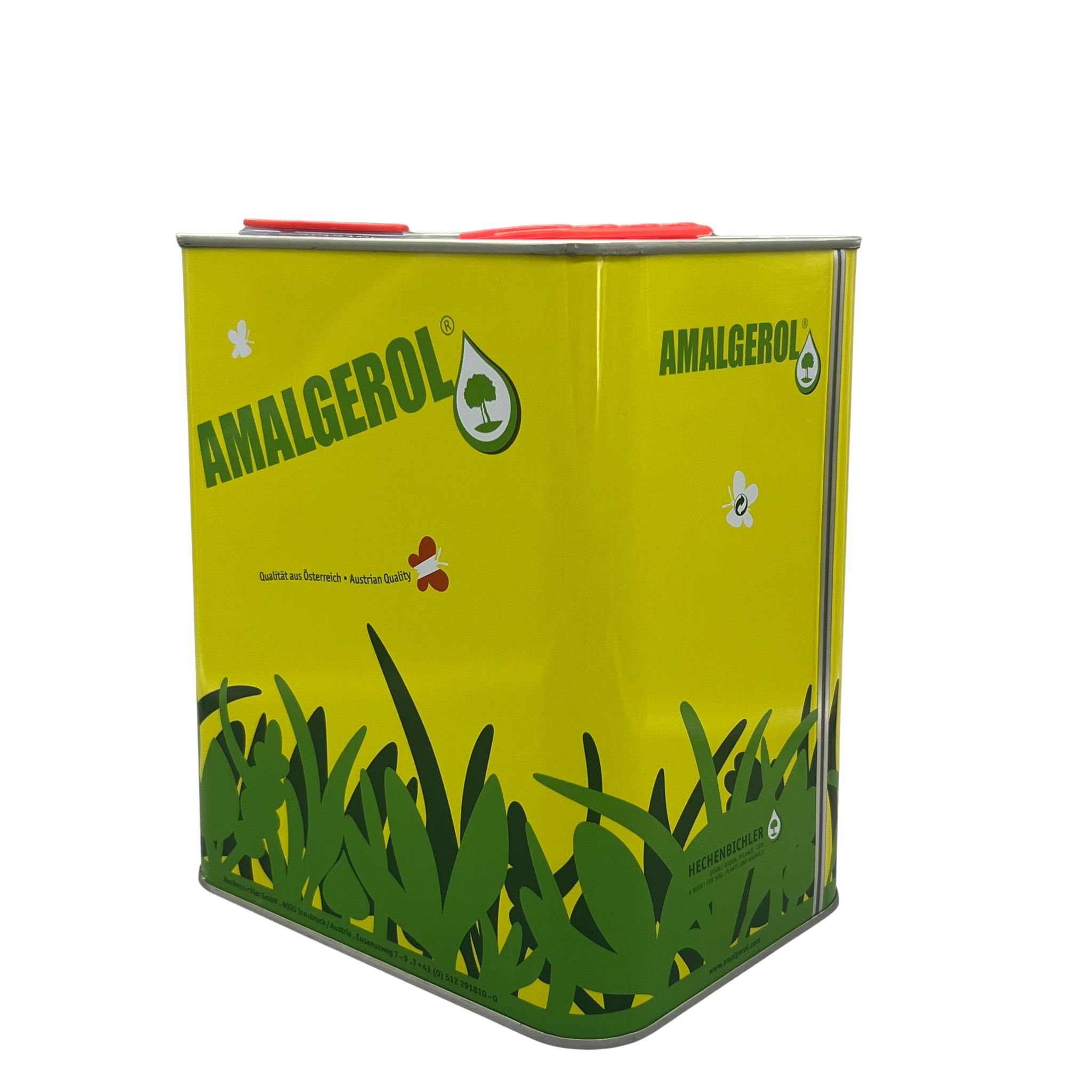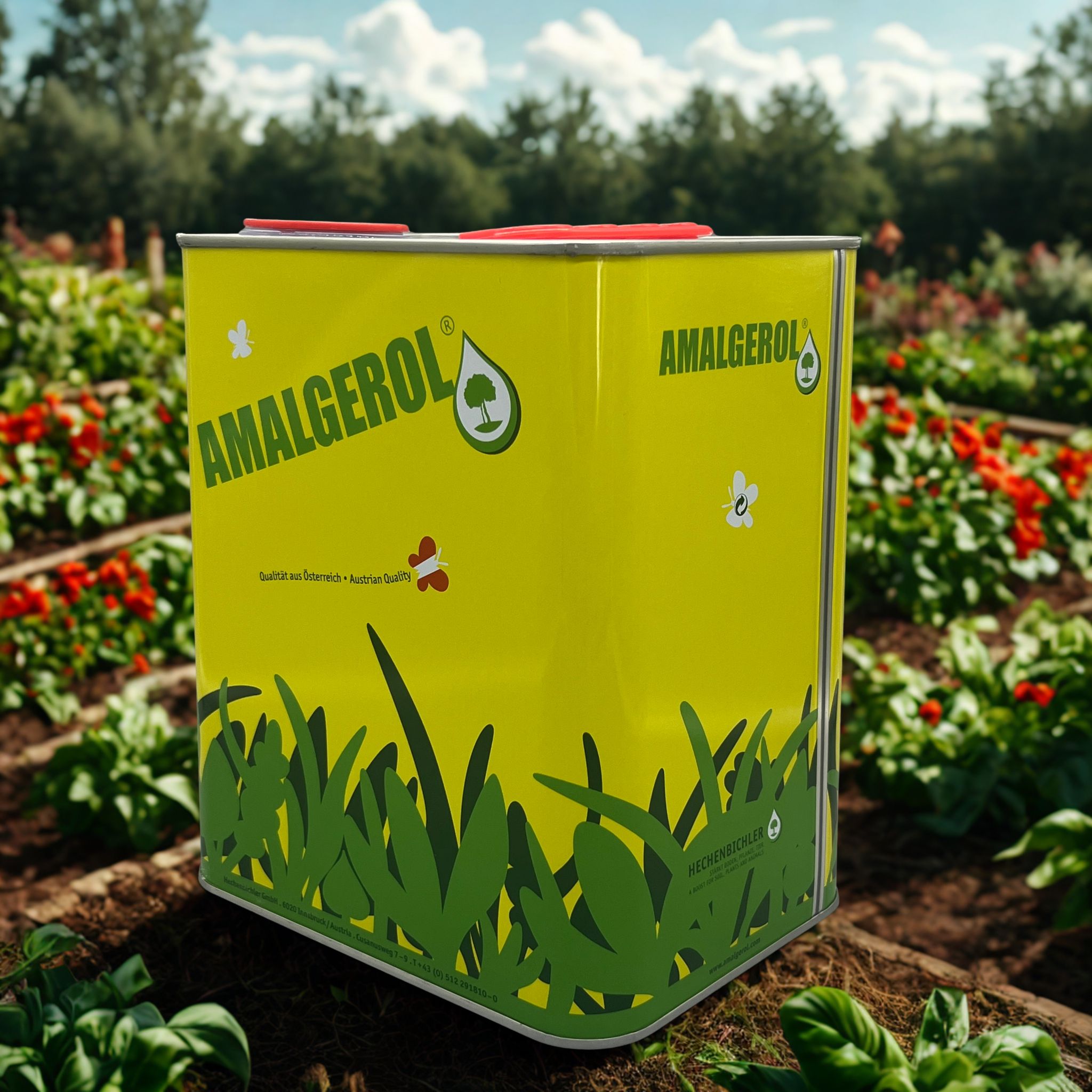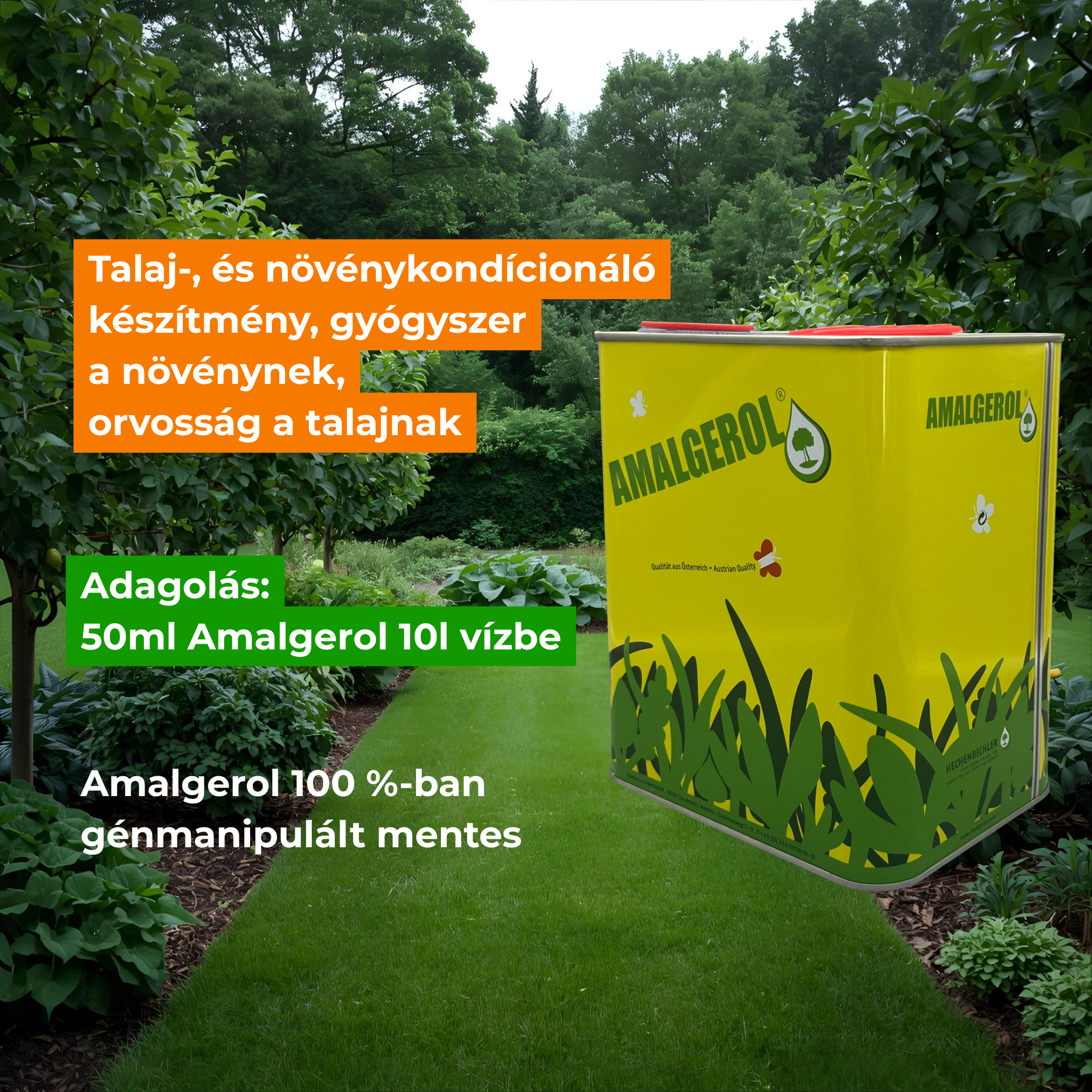Amalgerol 3 l
| HUF 19,580 * (nettó: HUF 15,417) | |
Soil and plant conditioner.
Medicine for the plant, medicine for the soil.
Mode of action and effectiveness
Amalgerol is a product developed by a Swiss chemist.
It is composed mainly of animal and vegetable oils, herbal extracts, trace elements, essences and a minimal amount of algae extract. Amalgerol is made from 100 % GMO-free raw materials and is fully biodegradable after application without any environmental impact.
What is its impact on soil life?
Amalgerol is an easily digestible carbon source for beneficial soil micro-organisms. It can be applied by irrigation or spraying. The mixture is also applied to the soil by spraying as appropriate. The treatment results in a very rapid and significant (176%) increase in the soil of the bacteria that are indigenous to our area and accelerate the decomposition processes that are beneficial to us.
This, and the fact that the number of plant-preferring organisms (e.g. acidic, waterlogged, airless soil) and micro-organisms that cause adverse effects (e.g. potato canker, root rot, fusarium root rot, etc.), and higher soil-dwelling pests (nematodes, soil-dwelling insect pests, etc.). Transforms and reduces weed infestation in the area.
Significant proliferation and activity of beneficial bacteria results in faster organic matter decomposition, formation of organic colloids, causing measurable soil warming (+2°C). This in turn leads to faster plant emergence and growth. By completely decomposing the plant remains, we also eliminate the habitat and overwintering of pathogens that infect our next plant, i.e. the possibility of future re-infection.
Also part of this process is the formation of higher amounts of carbon dioxide (+10% CO2), which both provides another carbon source for soil bacteria and loosens soil clods. In the presence of moisture, the higher CO2 content forms carbonic acid, which makes the calcium content of the soil, for example, soluble and absorbable. The end of the decomposition process is significant nutrient uptake and availability. The increased colloid formation glues the soil dust fraction, i.e. the friable structure is formed. This then partially binds water (soil dew), and the formation of a friable structure significantly improves the drainage of excess soil water (inland water). This results in a healthy water/air ratio in the soil, which also has a significantly improved heat retention. Such soils are free of water-logged, airless, water-pressure spots. With a more active soil life, undesirable pesticide residues that were sprayed onto the land in previous years or years and which are still present 4-8 years after application, decompose much more quickly.
Improved soil life also results in the re-emergence of earthworms and a change in weed conditions. Soil up to 1 metre deep becomes friable. The germinating, emerging or hatching plant has easier physical access to easily available nutrients, which are easily available and are constantly being excavated in significantly higher quantities, due to the friable and dewy soil. The plant then roots better, germinates more quickly and simultaneously, and grows uniformly in the presence of +35% Zn, +30% P. This means less headaches when first weeding, e.g. sugar beet, onions, etc.
What effect does Amalgerol have on plants?
When Amalgerol is sprayed on the plant, the root hairiness is doubled. It can then absorb 15% more nitrogen, 72% more phosphorus and 89% more potassium. It is precisely because of this that it does not get cold (frost) or sick so easily. It is easier to survive days when the temperature is 45°C. It is easier to cope with the stress of hail or dust storms, windstorms and herbicides. There are several cases of Amalgerol bringing biennial crops back from death by hormone or total herbicide drift with almost no time or yield loss after or due to treatment.
The plant, due to the aforementioned changes in conditions and increased root hairiness, is practically given access to the nutrients it needs at the time and in the proportions it needs them, on a table (!). This is what gives our plants their angry green colour a few days after the treatments (soil and/or foliage).
A plant in good condition, being able to easily and quickly transport the nutrients it takes up from the soil for its genetically coded self-defence (!), is also better able to defend itself against attacks by pathogens.
The turgor of a plant treated in this way is much stronger and does not fall easily under the pressure of strong winds or irrigation water. It grows faster, matures earlier or produces longer because it does not senesce.
In flowers or underground, our plants also bind much better than without Amalgerol? Even in drought conditions, because of the good turgor, the plants don't wilt, the flowers can pollinate. Or, in the case of potatoes, it can be pointed out that, in addition to a much higher number of bindings, the tuber size will also be uniform. These tubers do not hollow out even when sprouted, precisely because of the harmonious supply and supply capacity.
All these factors mean that our plants not only produce more, but also produce significantly better quality. In the case of grapes, melons and sugar beet, the extra 1-3% sugar is accompanied by an improvement in other nutritional indicators. Malting barley also produces a higher amount of carbohydrates. In oilseed crops, an increase of 2-3% in oil content can be detected in almost all cases.
The canes of woody plants mature, e.g. precisely because of the high PK uptake, and thus the risk of frost is significantly lower. Herbaceous plants are also better able to withstand minus 5-6°C for the same reasons. Also on critical hot days, Amalgerol-treated plants have been shown to be better able to withstand a lack of rainfall and to survive long periods without rainfall.
Amalgerol-treated crops will set, last longer without deterioration and can be kept on the counter for longer. For the plant (apples, onions, potatoes), for example, the provision of the necessary Ca levels will improve the storability of the crop, because a healthily nourished crop, which is therefore stored in a healthy way, will also lose less water during storage and will shrivel less. The above is the result of complex processes. Everything is connected.
How do we use it?
Suggestions for use:
Amalgerol is applied at a vegetative, not just annual, rate of 8-15 l/ha, regardless of the crop variety. It is recommended to apply about 40% of the vegetative dose to the soil, sprayed and incorporated, before seedbed preparation, sowing, planting or immediately afterwards, e.g. by irrigation. In this case, the dosage is 4-5 l/ha when incorporated into the soil. The remainder of the vegetative dose should be applied to the crop during the pre-emergence sprays, evenly spaced between sprays at a maximum concentration of 1%, starting before flowering and continuing until the pre-harvest period. This usually means using a dose of 3 l/ha sprayed in one or more doses.
Small-scale dose:
50ml Amalgerol in 10l water
Large-scale use:
For faster breakdown of stubble residues, it is practical to apply an additional 4-5 litres per hectare in autumn by a combined application of 20 kg/ha urea and apply as described above.
In Kalászos: 3 l/ha in autumn to break down stubble residues, improve soil hygiene and promote root growth for more secure overwintering, and 3 l/ha in spring to prevent freezing or weed stress for better rooting. It is also advisable to use 3 l/ha in one pass with foliar protection before flowering for pollination and better grain coverage.
In rape: 2-3 l/ha in one pass with regulators is recommended in autumn. The effect of the treatment is that the use of the regulator stops the growth of the foliage, while Amalgerol stimulates increased root growth, which increases winter hardiness and frost tolerance. Doses are 2-3 l/ha in spring, also when regulators are applied, and 3-5 l/ha before flowering.
In maize, sunflower: 4-5 l/ha in one pass after sowing but before emergence to promote more uniform emergence. To manage late ground frost stress and promote root growth in maize and sunflower at 2-8 leaf stage, 3-5 l/ha, then use 3-5 l/ha before flowering to promote crop set at 3-5 l/ha.
In sugar beet: already recommended in one pass with broadcast herbicides for uniform and uniform emergence, mixing at 4-5 l/ha into the soil. For post-emergence herbicide stress management 3-4 l/ha and with foliar treatments to achieve strong condition, 2-3 l/ha in one pass.
In potatoes: mix into the soil with soil preparation or spray into the bush in one pass with planting at 4-5 l/ha first. Subsequent treatments should be continued in conjunction with pre-flowering potato disease treatments at a minimum rate of 3 l/ha. With subsequent stand management sprays, it is recommended to apply an additional 2-3 l/ha at least 2-3 times. In early sprouting potato crops, an extreme dose of 10 l/ha can be used to regenerate the crop very quickly to prevent late frosts during the thawing period.
Peas, beans: to promote root nodulation with higher nitrogen fixing bacteria, it is also advisable to treat the soil at 3-4 l/ha during soil preparation. Treatments against peronospora and aphids at 4-5 l/ha before flowering should be used at the same time to strengthen the resistance of the crop. The treatments have a delayed senescence of the stand.
In horticultural crops:
Vegetables, field peppers, tomatoes, soft fruit: it is also practical to treat the area with a soil preparation at a rate of 4-5 l/ha before sowing or planting. Prior to planting, water the nutrient-coated stock with a 0.5-1% solution or help the nutrient cubes by dipping to avoid planting stress. Further treatments should be continued for two weeks after planting and repeated every 10 days at doses of 2-4 l/ha, possibly in one pass with other stand management treatments. These treatments will also make the plants more resistant to viral and bacterial infections.
In root crops (peppers, tomatoes, cabbage, melons, etc.): in these crops, higher doses of soil treatment are strongly recommended already during planting preparation. Then, with a dose of 5-10 l/ha, the soil compaction, siltation and lack of correct crop rotation caused by several years of growing in the same place, increased water use and the combined pathological and insect problems can be remedied and improved spectacularly. Of course, it can be applied not only by spraying and incorporation, but also by irrigation through the drip system in one pass, even weekly. Extremely high doses do not cause any phytotoxic effects or lesions, but depending on the dose, there is a significant and spectacular improvement in soil life. Further treatments should be applied in a single pass with the stand management treatments at a dose of 2-4 l/ha or at a concentration of 0.2-0.4% (at 1000 l/ha water).
In vineyards and fruit plantations: the first treatments should be applied in the row management treatments to improve soil structure intensively at a dose of 4-5 l/ha for the whole field. Subsequent treatments should be started before flowering and continued with further sprays in a single pass every second spray at a dose of 2-4 l/ha. Treatments will reduce the effects of stress (drought, prolonged waterlogging, pesticide sprays, etc.).
| Weight: | 3.09 kg |
|---|---|
| Width: | 100 mm |
| Height: | 100 mm |
| Length: | 220 mm |
| Aviability: | 1-4 nap |
| Basic sales unit: | db |
| Culture: | Bio, Díszkert, Dísznövény, Gyümölcs, Pázsit, Szobanövény, Zöldség |
Login
Login


